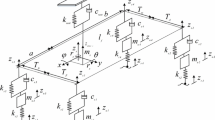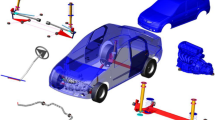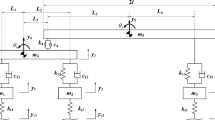Abstract
Ride and handling are two paramount factors in design and development of vehicle suspension systems. Conflicting trends in ride and handling characteristics propel engineers toward employing multi-objective optimization methods capable of providing the best trade-off designs compromising both criteria simultaneously. Although many studies have been performed on multi-objective optimization of vehicle suspension system, only a few of them have used probabilistic approaches considering effects of uncertainties in the design. However, it has been proved that optimum point obtained from deterministic optimization without taking into account the effects of uncertainties may lead to high-risk points instead of optimum ones. In this work, reliability-based robust multi-objective optimization of a 5 degree of freedom (5-DOF) vehicle suspension system is performed using method of non-dominated sorting genetic algorithm-II (NSGA-II) in conjunction with Monte Carlo simulation (MCS) to obtain best designs considering both comfort and handling. Road profile is modeled as a random function using power spectral density (PSD) which is in better accordance with reality. To accommodate the robust approach, the variance of all objective functions is also considered to be minimized. Also, to take into account the reliability criterion, a reliability-based constraint is considered in the optimization. A deterministic optimization has also been performed to compare the results with probabilistic study and some other deterministic studies in the literature. In addition, sensitivity analysis has been performed to reveal the effects of different design variables on objective functions. To introduce the best trade-off points from the obtained Pareto fronts, TOPSIS method has been employed. Results show that optimum design point obtained from probabilistic optimization in this work provides better performance while demonstrating very good reliability and robustness. However, other optimum points from deterministic optimizations violate the regarded constraints in the presence of uncertainties.
Similar content being viewed by others
References
JAZAR R N. Vehicle dynamics: theory and application [M]. Springer Science & Business Media: 2013.
DODDS C J, ROBSON J D. The description of road surface roughness [J]. Journal of Sound and Vibration, 1973, 31(2): 175–83.
GONZA'LEZ A, O'BRIEN E J, Li Y Y, CASHELL K. The use of vehicle acceleration measurements to estimate road roughness [J]. Vehicle System Dynamics, 2008, 46(6): 483–499.
HE L, QIN G, ZHANG Y, CHEN L. Non-stationary random vibration analysis of vehicle with fractional damping [C]// Intelligent Computation Technology and Automation (ICICTA), IEEE, 2008: 150–157.
TYAN F, HONG Y F, TU S H, JENG W S. Generation of random road profiles [J]. Journal of Advanced Engineering, 2009: 4(2): 1373–1378.
ZHANG Y Q, ZHAO Y S, YANG J, CHEN L P. A dynamic sliding-mode controller with fuzzy adaptive tuning for an active suspension system [J]. Proceedings of the Institution of Mechanical Engineers, Part D: Journal of Automobile Engineering, 2007, 221(4): 417–428.
SALTELLI A, CHAN K, SCOTT E M. Sensitivity analysis [M]. New York: Wiley, 2000.
AMBRÓSIO J, VERISSIMO P. Sensitivity of a vehicle ride to the suspension bushing characteristics [J]. Journal of Mechanical Science and Technology, 2009, 23(4): 1075–1082.
XU W T, LIN J H, ZHANG Y H, KENNEDY D, WILLIAMS F W. Pseudo-excitation-method-based sensitivity analysis and optimization for vehicle ride comfort [J]. Engineering Optimization, 2009, 41(7): 699–711.
AYDIN M, ÜNLÜSOY Y S. Optimization of suspension parameters to improve impact harshness of road vehicles [J]. The International Journal of Advanced Manufacturing Technology, 2012, 60(5-8): 743–754.
KARNOPP D. Analytical results for optimum actively damped suspensions under random excitation [J]. Journal of Vibration, Acoustics, Stress, and Reliability in Design, 1989, 111(3): 278–282.
HAC A, YOUN I. Optimal semi-active suspension with preview based on a quarter car model [J]. Journal of Vibration and Acoustics, 1992, 114(1): 84–92.
BAUMAL A E, MCPHEE J J, CALAMAI P H. Application of genetic algorithms to the design optimization of an active vehicle suspension system [J]. Computer Methods in Applied Mechanics and Engineering, 163(1): 87-94.
CHI Z, HE Y, NATERER G F. Design optimization of vehicle suspensions with a quarter-vehicle model [J]. CSME Transactions, 2008, 32(2): 297–312.
ALKHATIB R, JAZAR G N, GOLNARAGHI M F. Optimal design of passive linear suspension using genetic algorithm [J]. Journal of Sound and Vibration, 2004, 275(3): 665–691.
SUN L, CAI X, YANG J. Genetic algorithm-based optimum vehicle suspension design using minimum dynamic pavement load as a design criterion [J]. Journal of Sound and Vibration, 2007, 301(1): 18–27.
BOUAZARA M. Etude et anaslyse de la suspension active et semi-active des vehicules routters [D]. Laval: Universite Laval, 1997. (In French)
NARIMAN-ZADEH N, SALEHPOUR M, JAMALI A, HAGHGOO E. Pareto optimization of a five-degree of freedom vehicle vibration model using a multi-objective uniform-diversity genetic algorithm (MUGA) [J]. Engineering Applications of Artificial Intelligence, 2010, 23(4): 543–551.
GEORGIOU G, VERROS G, NATSIAVAS S. Multi-objective optimization of quarter-car models with a passive or semi-active suspension system [J]. Vehicle System Dynamics, 2007, 45(1): 77–92.
CREWS J H, MATTSON M G, BUCKNER G D. Multi-objective control optimization for semi-active vehicle suspensions [J]. Journal of Sound and Vibration, 2011, 330(23): 5502–5516.
KHALKHALI A, NARIMAN-ZADEH N, DARVIZEH A, MASOUMI A, NOTGHI B. Reliability-based robust multi-objective crashworthiness optimisation of S-shaped box beams with parametric uncertainties [J]. International Journal of Crashworthiness, 2010, 15(4): 443–456.
PAPADRAKAKIS M, LAGAROS N D, PLEVRIS V. Structural optimization considering the probabilistic system response [J]. Theoretical and Applied Mechanics, 2004, 31(3-4): 361–394.
GOBBI M, LEVI F, MASTINU G. Multi-objective stochastic optimisation of the suspension system of road vehicles [J]. Journal of Sound and Vibration, 2006, 298(4): 1055–1072.
GATTI C, PIOVAN M T. Dynamic analysis of models for suspension systems of ground vehicles with uncertain parameters [C]//Congreso Argentino de Mecánica Computacional. Salta, 2012: 2745–2755.
JAMALI A, SALEHPOUR M, NARIMAN-ZADEH N. Robust Pareto active suspension design for vehicle vibration model with probabilistic uncertain parameters [J]. Multibody System Dynamics, 2013, 30(3): 265–285.
SHOJAEEFARD M H, KHALKHALI A, MIANDOABCHI E. Multi-criteria decision making approach for selecting the best friction distribution in superplastic forming of a vehicle component [J]. Proceedings of the Institution of Mechanical Engineers, Part E: Journal of Process Mechanical Engineering, 2016, 230(2): 146–157.
LI X R. Probability, random signals, and statistics [M]. Florida: CRC press, 1999.
BRANDT A. Noise and vibration analysis: signal analysis and experimental procedures [M]. West Sussex, United Kingdom: John Wiley & Sons, 2011.
CAO J T, LI P, LIU H. An interval fuzzy controller for vehicle active suspension systems [J]. IEEE Transactions on Intelligent Transportation Systems, 2010, 11(4): 885–895.
DEB K, PRATAP A, AGARWAL S, MEYARIVAN T A. A fast and elitist multiobjective genetic algorithm: NSGA-II [J]. Evolutionary Computation, IEEE Transactions on, 2002, 6(2): 182–197.
HAMBY D M. A review of techniques for parameter sensitivity analysis of environmental models [J]. Environmental Monitoring and Assessment, 1994, 32(2): 135–154.
SMITH N D. Understanding parameters influencing tire modeling. Formula SAE Platform [D]. Colorado, United States: Colorado State University, 2004.
Author information
Authors and Affiliations
Corresponding author
Rights and permissions
About this article
Cite this article
Khalkhali, A., Sarmadi, M. & Yousefi, S. Reliability-based robust multi-objective optimization of a 5-DOF vehicle vibration model subjected to random road profiles. J. Cent. South Univ. 24, 104–113 (2017). https://doi.org/10.1007/s11771-017-3413-0
Received:
Accepted:
Published:
Issue Date:
DOI: https://doi.org/10.1007/s11771-017-3413-0




